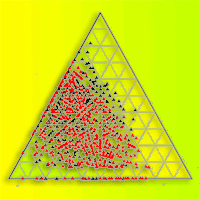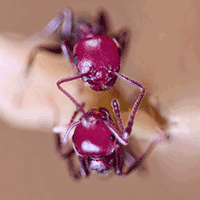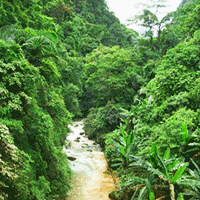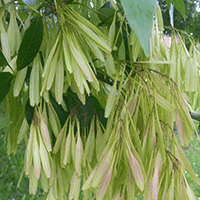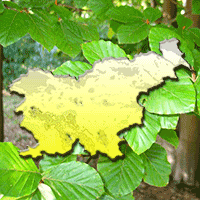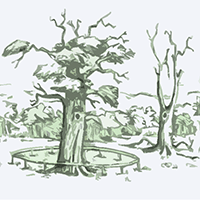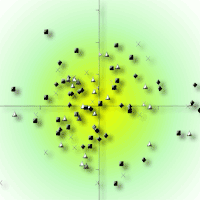The Formica rufa group comprises several ant species which are collectively referred to as “red wood ants” (hereafter RWA). These species have key roles in forest ecosystems, where they are ecologically dominant and greatly influence the dynamics of the habitat they colonise. Various studies have shown how their trophic activity may affect other organisms, which include both other invertebrates and plants. We can therefore hypothesize that their presence could affect the taxonomic and functional composition of epiphytes, despite clear information on such an effect is lacking. This study aimed to fill this research gap by evaluating whether the presence of red wood ants could affect the structure and composition of lichen communities. We selected two sites on the Apennine Mountains in Italy, where the red wood ant F. paralugubris was introduced from the Alps more than 50 years ago. In each site, lichen assemblages on Abies alba trees located within the colonised areas were compared to those from nearby, non-occupied areas. The results allowed for the identification of significant effects of F. paralugubris on the structure of lichen communities. Although there was no detectable impact on lichen species richness, a significant difference in their community composition between colonised and control sites was detected. Furthermore, ant presence seemed to be associated with specific lichen functional traits such as asexual reproduction. We argue that RWA could affect the lichen community either directly, e.g., by actively dispersing the species capable of asexual reproduction through their movements on trees (ant-mediated dispersion), or indirectly through herbivore exclusion. Finally, we also observed differences in β-diversity among the colonised and non-colonised sites.
Keywords
, , , , ,
Citation
Di Nuzzo L, Masoni A, Frizzi F, Bianchi E, Castellani MB, Balzani P, Morandi F, Sozzi Y, Vallese C, Santini G, Benesperi R (2022). Red wood ants shape epiphytic lichen assemblages in montane silver fir forests. iForest 15: 71-76. - doi: 10.3832/ifor3897-014
Academic Editor
Massimo Faccoli
Paper history
Received: Jun 10, 2021
Accepted: Dec 27, 2021
First online: Feb 22, 2022
Publication Date: Feb 28, 2022
Publication Time: 1.90 months
© SISEF - The Italian Society of Silviculture and Forest Ecology 2022
Open Access
This article is distributed under the terms of the Creative Commons Attribution-Non Commercial 4.0 International (https://creativecommons.org/licenses/by-nc/4.0/), which permits unrestricted use, distribution, and reproduction in any medium, provided you give appropriate credit to the original author(s) and the source, provide a link to the Creative Commons license, and indicate if changes were made.

Breakdown by View Type
(Waiting for server response...)
Article Usage
Total Article Views: 31900
(from publication date up to now)
Breakdown by View Type
HTML Page Views: 27282
Abstract Page Views: 2354
PDF Downloads: 1746
Citation/Reference Downloads: 4
XML Downloads: 514
Web Metrics
Days since publication: 1397
Overall contacts: 31900
Avg. contacts per week: 159.84
Article Citations
Article citations are based on data periodically collected from the Clarivate Web of Science web site
(last update: Mar 2025)
Total number of cites (since 2022): 6
Average cites per year: 1.50
Publication Metrics
by Dimensions ©
Articles citing this article
List of the papers citing this article based on CrossRef Cited-by.
(1)
Aho T, Kuitunen M, Suhonen J, Jäntti A, Hakkari T (1999)Reproductive success of eurasian treecreepers,
Certhia familiaris, lower in territories with wood ants. Ecology 80: 998-1007.
CrossRef |
Gscholar
(2)
Anderson MJ (2001)A new method for non-parametric multivariate analysis of variance. Austral Ecology 26: 32-46.
CrossRef |
Gscholar
(3)
André HM (1985)Associations between corticolous microarthropod communities and epiphytic cover on bark. Ecography 8: 113-119.
CrossRef |
Gscholar
(4)
Asplund J, Wardle DA (2017)How lichens impact on terrestrial community and ecosystem properties. Biological Reviews 92: 1720-1738.
CrossRef |
Gscholar
(5)
Bailey RH (1970)Animals and the dispersal of soredia from
Lecanora conizaeoides NYL. Ex cromb. The Lichenologist 4: 256-256.
CrossRef |
Gscholar
(6)
Balzani P, Vizzini S, Frizzi F, Masoni A, Lessard JP, Bernasconi C, Francoeur A, Ibarra-Isassi J, Brassard F, Cherix D, Santini G (2021)Plasticity in the trophic niche of an invasive ant explains establishment success and longÂÂterm coexistence. Oikos 130 (5): 691-696.
CrossRef |
Gscholar
(7)
Bartolini G, Grifoni D, Magno R, Torrigiani T, Gozzini B (2018)Changes in temporal distribution of precipitation in a Mediterranean area (Tuscany, Italy) 1955-2013. International Journal of Climatology 38: 1366-1374.
CrossRef |
Gscholar
(8)
Benesperi R, Tretiach M (2004)Differential land snail damage to selected species of the lichen genus
Peltigera. Biochemical Systematics and Ecology 32: 127-138.
CrossRef |
Gscholar
(9)
Buhl J, Hicks K, Miller ER, Persey S, Alinvi O, Sumpter DJT (2009)Shape and efficiency of wood ant foraging networks. Behavioral Ecology and Sociobiology 63: 451-460.
CrossRef |
Gscholar
(10)
Caradonna PJ, Burkle LA, Schwarz B, Resasco J, Knight TM, Benadi G, Blüthgen N, Dormann CF, Fang Q, Fründ J, Gauzens B, Kaiser-Bunbury CN, Winfree R, Vázquez DP (2021)Seeing through the static: the temporal dimension of plant-animal mutualistic interactions. Ecology Letters 24 (1): 149-161.
CrossRef |
Gscholar
(11)
Chapuisat M, Keller L (1999)Extended family structure in the ant
Formica paralugubris: the role of the breeding system. Behavioral Ecology and Sociobiology 46: 405-412.
CrossRef |
Gscholar
(12)
Clarke KR, Warwick RM (2001)Change in marine communities: an approach to statistical analysis and interpretation. Primer-E Ltd, Plymouth, UK, pp. 262.
Gscholar
(13)
Domisch T, Risch AC, Robinson EJH (2016)Wood ant foraging and mutualism with aphids. In: “Wood Ant Ecology and Conservation”. Cambridge University Press, Cambridge, UK, pp. 145-176.
CrossRef |
Gscholar
(14)
Ellis S, Robinson EJH (2016)Internest food sharing within wood ant colonies: resource redistribution behavior in a complex system. Behavioral Ecology 27: 660-668.
CrossRef |
Gscholar
(15)
Frizzi F, Masoni A, Quilghini G, Ciampelli P, Santini G (2018)Chronicle of an impact foretold: the fate and effect of the introduced
Formica paralugubris ant. Biological Invasions 20: 3575-3589.
CrossRef |
Gscholar
(16)
Frizzi F, Masoni A, Migliorini M, Fanciulli PP, Cianferoni F, Balzani P, Giannotti S, Davini G, Frasconi Wendt C, Santini G (2020)A comparative study of the fauna associated with nest mounds of native and introduced populations of the red wood ant
Formica paralugubris. The European Journal of Soil Biology 101: 103241.
CrossRef |
Gscholar
(17)
Frouz J, Jílková V, Sorvari J (2016)Contribution of wood ants to nutrient cycling and ecosystem function. In: “Wood Ant Ecology and Conservation”. Cambridge University Press, Cambridge, UK, pp. 207-220.
Online |
Gscholar
(18)
Gauslaa Y, Holien H, Ohlson M, Solhy T (2006)Does snail grazing affect growth of the old forest lichen
Lobaria pulmonaria? The Lichenologist 38: 587-593.
CrossRef |
Gscholar
(19)
Giordani P, Rizzi G, Caselli A, Modenesi P (2016)Fire affects the functional diversity of epilithic lichen communities. Fungal Ecology 20: 49-55.
CrossRef |
Gscholar
(20)
Gonnelli V, Bottacci A (2009)Il clima di Sasso Fratino [The climate of Sasso Fratino]. In: La Riserva naturale integrale di Sasso Fratino: 1959-2009. 50 anni di conservazione della biodiversità [The integral natural reserve of Sasso Fratino: 1959-2009. 50 years of biodiversity conservation]. CFS/UTB, Pratovecchio, Arezzo, pp. 39-46. [in Italian]
Gscholar
(21)
Gorb E, Gorb S (2003)Seed dispersal by ants in a deciduous forest ecosystem: mechanisms, strategies, adaptations. Kluwer Academic Publishers, Dordrecht, The Netherlands, pp. 225.
Online |
Gscholar
(22)
Groppali R, Crudele G (2005)Le formiche del gruppo Formica rufa trapiantate nel Parco nazionale delle Foreste Casentinesi, Monte Falterona e Campigna [Red wood ants (
Formica rufa group) introduced in the Foreste Casentinesi, Monte Falterona and Campigna National Park]. Quaderni di Studi e Notizie di Storia Naturale della Romagna, Cesena 20: 63-73. [in Italian]
Gscholar
(23)
Heinken T, Rohner M-S, Hoppert M (2007)Red wood ants (
Formica rufa group) disperse bryophyte and lichen fragments on a local scale. Nova Hedwigia: Beiheft 131: 147-163.
Online |
Gscholar
(24)
Herrera CM, Pellmyr O (2009)Plant animal interactions: an evolutionary approach. Blackwell Science Ltd., Oxford, UK, pp. 334.
Online |
Gscholar
(25)
Hurtado P, Prieto M, Martínez-Vilalta J, Giordani P, Aragón G, López-Angulo J, Košuthová A, Merinero S, Díaz-Peña EM, Rosas T, Benesperi R, Bianchi E, Grube M, Mayrhofer H, Nascimbene J, Wedin M, Westberg M, Martínez I (2020)Disentangling functional trait variation and covariation in epiphytic lichens along a continent-wide latitudinal gradient. Proceedings of the Royal Society B: Biological Sciences 287: 20192862.
CrossRef |
Gscholar
(26)
Kerney M (1999)Atlas of the land and freshwater mollusca of Britain and Ireland. Brill, Leida, The Netherlands, pp. 272.
Gscholar
(27)
Lach L, Parr C, Abbott K (2010)Ant ecology. Oxford University Press, Oxford, UK, pp. 432.
Online |
Gscholar
(28)
Lavorel S, Grigulis K, McIntyre S, Williams NSG, Garden D, Dorrough J, Berman S, Quétier F, Thébault A, Bonis A (2008)Assessing functional diversity in the field - methodology matters! Functional Ecology 22: 134-147.
CrossRef |
Gscholar
(29)
Lorentsson S, Mattsson J-E (1999)New Reports of soredia dispersed by ants,
Formica cunicularia. The Lichenologist 31: 204-207.
CrossRef |
Gscholar
(30)
Marini L, Nascimbene J, Nimis PL (2011)Large-scale patterns of epiphytic lichen species richness: photobiont-dependent response to climate and forest structure. Science of the Total Environment 409: 4381-4386.
CrossRef |
Gscholar
(31)
Masoni A, Frizzi F, Natali C, Bernasconi C, Ciofi C, Santini G (2019)Molecular identification of imported red wood ant populations in the Campigna Biogenetic Nature Reserve (Foreste Casentinesi National Park, Italy). Conservation Genetics Resources 11: 231-236.
CrossRef |
Gscholar
(32)
Matteucci E, Benesperi R, Giordani P, Piervittori R, Isocrono D (2012)Epiphytic lichen communities in chestnut stands in Central-North Italy. Biologia (Bratislava) 67: 61-70.
CrossRef |
Gscholar
(33)
Nascimbene J, Lazzaro L, Benesperi R (2015)Patterns of β-diversity and similarity reveal biotic homogenization of epiphytic lichen communities associated with the spread of black locust forests. Fungal Ecology 14: 1-7.
CrossRef |
Gscholar
(34)
Nash TH (2008)Lichen biology. Cambridge University Press, Cambridge, UK, pp. 502.
Gscholar
(35)
Nimis PL, Martellos S (2020)ITALIC 6.0 - the information system on Italian lichens. Web site.
Online |
Gscholar
(36)
Ohashi M, Kilpeläinen J, Finér L, Risch AC, Domisch T, Neuvonen S, Niemelä P (2007)The effect of red wood ant (
Formica rufa group) mounds on root biomass, density, and nutrient concentrations in boreal managed forests. Journal of Forest Research 12 (2): 113-119.
CrossRef |
Gscholar
(37)
Pike LH (1978)The importance of epiphytic lichens in mineral cycling. The Bryologist 81: 247-257.
CrossRef |
Gscholar
(38)
Pla L, Casanoves F, Di Rienzo J (2012)Functional diversity indices. In: “Quantifying Functional Biodiversity”. Springer, Dordrecht, Netherlands, pp. 27-51.
CrossRef |
Gscholar
(39)
Podani J, Schmera D (2011)A new conceptual and methodological framework for exploring and explaining pattern in presence-absence data. Oikos 120: 1625-1638.
CrossRef |
Gscholar
(40)
Porada P, Van Stan JT, Kleidon A (2018)Significant contribution of non-vascular vegetation to global rainfall interception. Nature Geoscience 11: 563-567.
CrossRef |
Gscholar
(41)
Punttila P, Niemelä P, Karhu K (2004)The impact of wood ants (Hymenoptera: Formicidae) on the structure of invertebrate community on mountain birch (
Betula pubescens ssp.
czerepanovii). Annales Zoologici Fennici 41: 429-446.
Online |
Gscholar
(42)
Rico-Gray V, Oliveira PS (2007)The ecology and evolution of ant-plant interactions. University of Chicago Press, Chicago, IL, USA, pp. 320.
CrossRef |
Gscholar
(43)
Risch AC, Ellis S (2016)Where and why? Wood ant population ecology. In: “Wood Ant Ecology and Conservation”. Cambridge University Press, Cambridge, UK, pp. 81-105.
Online |
Gscholar
(44)
Robinson EJH, Stockan JA, Iason GR (2016)Wood ants and their interaction with other organisms. In: “Wood Ant Ecology and Conservation”. Cambridge University Press, Cambridge, UK, pp. 177-206.
CrossRef |
Gscholar
(45)
Stockan JA, Robinson EJH (2016)Wood ant ecology and conservation. Cambridge University Press, Cambridge, UK, pp. 304.
Online |
Gscholar
(46)
Thunes KH, Gjerde I, Skartveit J (2018)The red wood ant
Formica aquilonia (Hymenoptera: Formicidae) may affect both local species richness and composition at multiple trophic levels in a boreal forest ecosystem. Annales Zoologici Fennici 55: 159-172.
CrossRef |
Gscholar
(47)
Wardle DA, Hyodo F, Bardgett RD, Yeates GW, Nilsson MC (2011)Long-term aboveground and belowground consequences of red wood ant exclusion in boreal forest. Ecology 92: 645-656.
CrossRef |
Gscholar
(48)
Zuur A, Ieno EN, Walker N, Saveliev AA, Smith GM (2009)Mixed effects models and extensions in ecology with R. Springer, New York, USA, pp. 596.
CrossRef |
Gscholar
